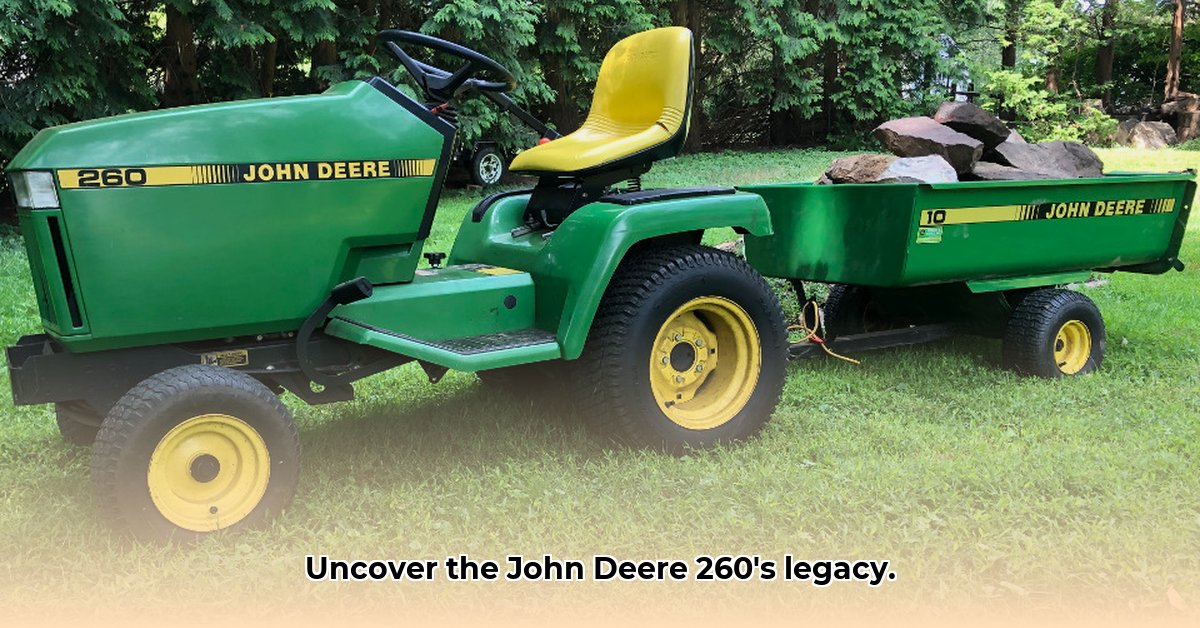
The John Deere 260 lawn tractor, produced approximately between 1987 and 1991, represents a significant point in the evolution of lawn care equipment. This article examines its specifications, historical context, and surprisingly nuanced relationship to modern concepts of sustainable agriculture. We will explore its capabilities, market value, and the challenges of comparing its fuel efficiency to that of contemporary sustainable tractors. For more information on John Deere products, check out this useful resource.
Specifications and Features
The John Deere 260 featured a robust design prioritizing functionality over advanced features. Power came from a Kawasaki engine, typically rated at approximately 17 horsepower (a measure of engine power output). This engine drove a six-speed manual transmission (a system for changing gears), providing operators with precise speed control over various terrains. A 46-inch mid-mount cutting deck (the part that cuts the grass) offered efficient mowing capabilities. The tractor's adaptability extended through the availability of various attachments, including snow blowers and tillers, expanding its functionality beyond simple mowing.
| Feature | Specification |
|---|---|
| Engine | Kawasaki (approx. 17 horsepower) |
| Transmission | 6-speed manual gear |
| Cutting Deck | 46-inch mid-mount |
| Attachments | Snow blower, tiller, blade, etc. |
| Production Years | Approximately 1987-1991 |
Performance and Capabilities
The 260's powerful engine and six-speed transmission enabled efficient mowing across uneven ground. Its wide cutting deck maximized coverage, minimizing time spent on larger lawns. However, compared to modern, self-propelled, and often robotic lawn tractors, its operation required more manual input. This difference highlights technological advancements improving efficiency and ease of use.
Historical Context and Evolution
The John Deere 260 reflects the design philosophies of its era. Unlike modern tractors with electronic controls and complex features, its more straightforward design emphasized reliability and functionality. Its placement in the timeline of agricultural machinery evolution offers a valuable comparison point for understanding how technology and design priorities have changed over time. The transition from simpler, manually operated machines to more sophisticated, automated systems is captured by this tractor's design.
Sustainability Considerations
Assessing the John Deere 260's sustainability requires a nuanced approach. While not designed with modern sustainability principles in mind, several aspects warrant consideration. Its engine size, relative to some contemporary models, may have resulted in slightly lower fuel consumption per acre mowed. Additionally, the tractor's durability and collector appeal suggest a longer lifespan than some modern designs built with planned obsolescence. However, it lacks the fuel-efficient technologies and eco-friendly materials found in today's sustainable equipment. Therefore, while its longevity is a positive aspect, it does not meet current rigorous standards for sustainable machinery.
Market Value and Availability
Finding a used John Deere 260 requires dedicated searching. Online auction sites, classified ads, and agricultural equipment dealerships are potential sources. Pricing varies based on condition, location, and included attachments. The tractor's age and potential collector value can also influence its market price.
Conclusion: A Legacy of Reliability
The John Deere 260, though not a model of modern sustainability, offers a compelling historical perspective on agricultural machinery. Its reliability, practicality, and enduring presence in the market illustrate the impact of durable design principles. While not a leader in modern sustainable practices, its story contributes to the larger evolution of environmentally conscious equipment design. Its enduring appeal amongst collectors and users highlights its lasting value. The tractor stands as a testament to the continuous improvement in agricultural technology and the ever-evolving definition of sustainability.